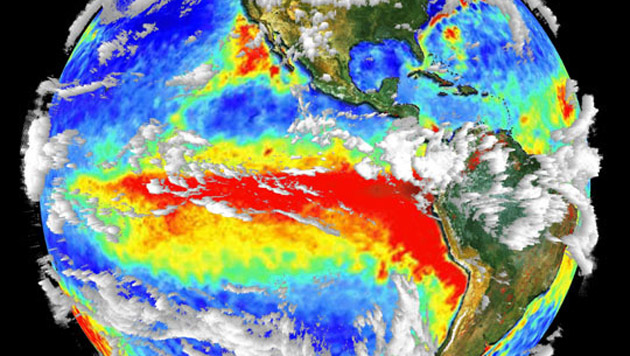A new study has been published within Nature Geoscience that looks back over historical El Nino events to see how it has changed. Titled “Higher frequency of Central Pacific El Niño events in recent decades relative to past centuries“, it highlights that recent El Nino events have become far more intense.
What exactly is El Nino?
There is a nice explanation of it here …
The simplest way to understand El Niño and La Niña is through the sloshing around of warm water in the ocean.
The top layer of the tropical Pacific Ocean (about the first 200 metres) is warm, with water temperatures between 20C and 30C. Underneath, the ocean is colder and far more static. Between these two water masses there is a sharp temperature change known as the thermocline.
Winds over the tropical Pacific, known as the trade winds, blow from east to west piling the warm top layer water against the east coast of Australia and Indonesia. Indeed, the sea level near Australia can be one metre higher than at South America.
Warm water and converging winds near Australia contribute to convection, and hence rainfall for eastern Australia.
In a La Niña event, the trade winds strengthen bringing more warm water to Australia and increasing our rainfall totals.
In an El Niño the trade winds weaken, so some of the warm water flows back toward the east towards the Americas. The relocating warm water takes some of the rainfall with it which is why on average Australia will have a dry year.
In the Americas El Niño means increased rainfall, but it reduces the abundance of marine life. Typically the water in the eastern Pacific is cool but high in nutrients that flow up from the deep ocean. The warm waters that return with El Niño smother this upwelling.
Research Findings
How did the researchers look back over the history of El Nino events?
They used coral records to look back. It basically gives them a 400 year window to see past occurrences of the event and measure how it has changed over time.
What have they discovered?
They identify two distinct types of El Nino events, Eastern Pacific and Central Pacific …
What the new study does is to expand our understanding of El Nino events. By creating a view over the past 400 years a new pattern has emerged.
The more traditional version, the Eastern Pacific El Nino, has become far more intense in recent decades, and a new variation, the Central Pacific El Nino has become more common.
Observations from the paper
The diversity of El Niño events and the recent changes in their relative frequency and intensity challenge efforts to provide seasonal to decadal predictions. In 2014/2015, the ‘failed’ El Niño is categorized by our classification scheme as a CP event, whereas the following year, 2015/2016, closely resembled a canonical EP pattern and resulted in one of the strongest events in the past 400 years. This evolution of events appears unusual in the instrumental record; however, our reconstructions provide evidence that this sequence occurred at least eight times in the past 400 years.
Our 400 year reconstruction of EP and CP El Niño events gives a valuable long-term context to observational studies by showing that the shift towards more frequent CP events in recent decades and a tendency towards more extreme EP events is unusual relative to the past four centuries. During the past three decades, CP events have occurred more than four times as often as EP events. Under a high emissions scenario a projected increase in the CP/EP event ratio to 5:1 could occur by the end of the century. Our reconstructions may provide evidence for an earlier or more extreme shift towards CP El Niño events than is projected from some climate model simulations. Alternatively, this difference could be related to the difficulties representing the full range of ENSO diversity and variability in climate models. Large uncertainties in the tropical response to climate change may arise from a poorly con-strained mean state, manifested by a pronounced Pacific cold tongue bias, a doubled intertropical convergence zone and diverging dynamical responses. This presents challenges for future projections of CP El Niño events and their emerging global impacts. Expansion of the seasonally resolved coral network to include more paired Sr/Ca and δO records would provide a greater certainty around the site-specific sensitivities of δO to SST and δOSW and more precise reconstructions of past SST and ENSO events. However, our new reconstructions of El Niño diversity provide a valuable baseline of past variability and a con-text for recent changes. This provides an improved understanding of El Niño behaviour in a warming world.
Data Illustrations
Here is a data illustration that shows you the complete 400 year history …
B. Number Eastern Pacific (EP) events
C. Ratio of CP to EP events (30 year window)
D. Intensity of the CP El Niño (orange) and EP El Niño (purple) events
If you find that the book is too technical to digest, then you can always go watch the movie instead …
Further Reading
- An article by the author of the study, Mandy Freund, in The Conversation: El Niño has rapidly become stronger and stranger, according to coral records
- Another article by the author of the paper, Nature Research (May 7th 2019): Unraveling the history of El Niño flavours
